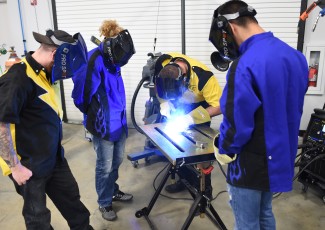Measuring the Value of a Degree
By Ellen Ullman
September 2, 2015
The Kentucky Community and Technical College System came up with a way to prove that a college education’s worth doesn’t start and end with employment.
It’s common knowledge, or at least a long-held assumption, that students get more than financial value from a college education. But how do you assess a nonmonetary return on investment?
Christina Whitfield, vice chancellor for research and analysis for the Kentucky Community and Technical College System (KCTCS), decided to find out.
Creating a degree-alignment tool
KCTCS had already conducted research on the labor market and had data on employment outcomes, average earnings and employment retention from various sources, including the U.S. Bureau of Labor Statistics’ Occupational Outlook Handbook; Burning Glass products; EMSI reports; and the KCTCS Unemployment Insurance Match.
Projected growth, annual openings, median wages, job postings and graduates’ earnings were studied to determine the labor markets of existing and new programs of study. The information collected would, for example, allow a college president to see whether she should start a dental hygiene program to accommodate a high demand for dental hygienists in the area.
“We need to think about realigning resources for programs with less positive outcomes to programs with better outcomes for students and colleges,” says Whitfield, “and this tool is intended to help college presidents operate more efficiently, particularly in times of constrained resources.”
However, Whitfield wanted to figure out how to incorporate the idea of social utility into the program ratings.
Finding a way to align nonmonetary returns
Whitfield was intrigued by the notion that lower-paying occupations often play a critical role in the community, and she wanted to give colleges a better way to figure out what should get funded.
“Early childhood and cosmetology programs both have poor employment outcomes, but most people will say that early childhood programs have more value than cosmetology programs. Doesn’t everything have social value or meaning to someone? How can we quantify that?” she asks.
Determined to quantify the qualitative, she came up with multiple criteria, including career pathways, job meaning and minority and gender representation. She looked at rates of civic participation, crime and incarceration, health and wellness, and smoking and obesity.
She used these metrics to create a social-utility index for the alignment tool.
According to the redesigned tool, occupations with a low LMI (low to moderate income) and high social utility include firefighters, child care workers and medical records technicians.
A work in progress
Although Whitfield is pleasantly surprised by how much attention the social-utility index has already received, she says it is not yet complete. She welcomes feedback from colleges and is excited that people in other states want to replicate the index or do something similar.
“Because of their mission, community colleges cannot ignore the importance of fields with a high social utility, and relying only on wage and demand data may underestimate the value of particular programs to students and communities.”







